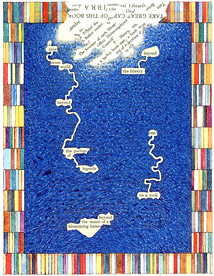W.H. Mallock and A Human Document by Daniel Traister
"The following work, though it has the form of a novel, yet for certain singular reasons hardly deserves the name."
This, the first sentence of Mallock's A Human Document, opens an "Introduction" which is a conventional authorial intervention assuring readers of the fundamental veracity of the tale they are about to read. What follows, the "Introduction" continues, is based on the scrapbooks and documents of real people, given to the narrator by a real person, which arrived neither ordered nor composed in any way. Their author's very identities require concealment.
Because of the nature of these manuscripts, the woman who provides the narrator with them comments, they are" something which ...[he] will have to pore and puzzle over. The narrator sees, despite their inchoate nature, that "some single thread of narrative" runs through them, "broken by pages after pages of letters, by scraps of poetry, and various other documents." The manuscripts are, the narrator concludes, "fragments of actual life" characterised by "baffled and crippled sentences," "abrupt transitions," and "odd lapses of grammar." "Mere nondescript fragments," they nonetheless add up, the narrator continues, to a woman's "life, and the life of another, turned literally inside out."
Well before it had reached Phillips, in other words, Mallock's text provided any interested reader with a recipe for its own construction, or re-construction, out of allegedly prior fragments. The method it proposed resembles in many ways what Phillips was to do with Mallock's novel itself. A Humument is a literal re-construction of A Human Document which Mallock (or his narrator) had allegedly constructed in much the same way, using materials just as refractory - and just as malleable. "As they stand," Mallock's narrator tells the lady, these materials "are not a story in any literary sense; though they enable us, or rather force us, to construct one out of them for ourselves."
The choice of a late Victorian novel to treat improved Phillips's chances of finding an appropriate vehicle for his project, wittingly or not. Underlying the apparent stability of Mallock's novel, and of the late Victorian period generally, is an undertone of instability. Often manifested as fear and uncertainty, this undertone might also have formal implications. The cut-and-paste method prescribed for the construction of a novel from the manuscripts Mallock's narrator receives recalls a form later to gain great significance in modern art: collage.
Collage became part of the standard repertory of techniques used by Cubists, Dadaists, and other modernists. They valued the technique both for its recuperation for art of materials not ordinarily considered as "art" and for its special ability to yoke unlike objects or fields of reference together in one visual field. Thus collage, a shaky assertion of stability, orders materials with no obvious or stable basis for their relationship into a framed composition. Many otherwise different modern sensibilities found these aspects of collage appealing. The technique relies on elements both of chance (what the artist could find that might work in the final assembly) and control (the artist determining the form which that assembly would take). Collage is a modern technique but it has older antecedents. The Sackner Archive, for example, contains an anonymous scrapbook dating from the end of the eighteenth century. It entered the Archive independently of Phillips and has no relationship to him. Yet its curiously "collage" -like techniques, which resemble practices later developed, far more self-consciously, by various twentieth century artists, offer a precedent for his achievement in A Humument much older than his more obvious modernist predecessors.
On its surface, Mallock's novel appears distinguished only by its utterly unrelieved conventionality. Yet Phillips's decision to adapt, or to "treat," this book may well be (as Phillips has always claimed) much more of a true collaboration between related artistic temperaments than at first meets the eye. Throughout his life and literary career, W.H. Mallock (1849 -1923) consistently tried to construct a politically conservative and religiously orthodox sanctuary from a world increasingly defined by modern science. "Construct" is the operative term here. No refuge could be entirely satisfactory which is merely found. It must instead be made by those people it would serve.
Mallock's political and religious views were threatened by many aspects of modernity. He sought nonetheless to construct an intellectually respectable means of reconciling the conflicting ways of apprehending the reality he experienced. But neither Mallock nor his contemporaries, however clearly they saw these threats and recognised their significance, could contain or control them. Their very efforts contained the seed of their failure. The undertone of radical instability often characteristic of their works reflects their awareness of this failure. Man-made constructs remain vulnerable to the alternative constructs of other people. Mallock, like many of his contemporaries, sought a kind of certainty which, finally, no man-made construct could provide. His disappearance from modern consciousness is a not completely unfair measure of the success with which his efforts at reconciliation met.
But it is not the only measure. For years, Mallock's A Human Document has been forgotten, Phillips's appropriation of the book has given it a new life. He has even revivified some of the cliches in which Mallock's "Introduction" abounds. So thoroughly does Phillips seem to build upon hints and instructions which litter the very surface of Mallock's "Introduction" that even to refer to "Phillips's appropriation" of Mallock is misleading. Surely, in an important sense, Mallock has "appropriated" Phillips.
Daniel Traister
Department of Special Collections, Van Pelt-Dietrich Library, University Of Pennsylvania

